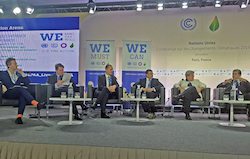Over the weekend UN Climate Change Conference (COP21) attendees made commitments to accelerate the ongoing energy transition through several initiatives discussed during the Lima-Paris Action Agenda Focus on Energy (LPAA). New analysis from the International Renewable Energy Agency (IRENA) finds that achieving a 36 percent share of renewable energy by 2030 would result in half of all emission reductions needed to maintain a two-degree pathway, while energy efficiency measures could supply the rest.

From left to right: Nick Nuttall (Moderator), UNFCC; Jean-Marc Ollagnier, CEO, Accenture Resources; Steve Howard, CSO, IKEA; Adnan Z. Amin, Director-General, IRENA; Rachel Kyte, incoming CEO, SE4All; Khaled Fahmy, Minister of Environment, Egypt, Chair of AMCEN
“With the energy sector accounting for some two-thirds of global greenhouse gas emissions, the decarbonisation of energy must be at the heart of any effort to keep global temperature rise below two degrees Celsius,” said IRENA Director-General Adnan Z. Amin. “The energy transition is underway worldwide but more action is needed. To scale up efforts to the level needed, we must utilise all available technologies, increase ambition among all actors in all regions of the world, and mobilise the funds needed to enable the transition.”
The announcements included new initiatives emerging to help further drive this transition including:
- The Global Geothermal Alliance launched during the event. This Alliance is set to achieve a 500% increase in global installed capacity for geothermal power generation and a 200% increase for geothermal heating by 2030. The world contains vast geothermal energy potential, proven across nearly 90 countries. However, almost 90% of this remains untapped with roughly 12 GW installed so far. What was only an idea a year ago, is now a partnership of 36 countries and 23 institutions with an action plan in place to guide its success.
- The Africa Clean Energy Corridor aims to boost renewable power deployment, reduce carbon emissions and support sustainable, climate-friendly economic growth. By facilitating a larger electricity market, the initiative could attract sufficient investments to meet half of all power needs in eastern and southern Africa by 2030. At COP21, IRENA and its partners announced efforts to develop a clean energy corridor in western Africa as well.
- The Small Island Developing States (SIDS) Lighthouses initiative announced that Saint Lucia is the 29th island to join the initiative. Since its launch in September 2014, 18 SIDS have developed roadmaps for deployment of renewable energy, USD 150 million has been mobilised for renewable energy projects on SIDS, and 18 MW of renewable energy has been deployed. The initiative will also announce a new pilot project development facility to help develop more bankable projects.
- To meet climate objectives, renewable energy uptake would need to increase six-fold from current levels. This would require global annual investment to nearly double to exceed USD 500 billion in the period up to 2020, and more than triple to exceed USD 900 billion from 2021 to 2030. The Sustainable Energy Marketplace was launched to provide a matchmaking platform for renewable energy projects and investors to connect. The Marketplace expects to house 100 projects by the beginning of 2016, and to mobilize USD 10 billion in project financing over the next 3 years.
These initiatives are the latest in a series of renewable energy announcements made during COP 21 including the African Renewable Electricity Program; Breakthrough Energy Coalition; and the Mission Innovation initiative.

